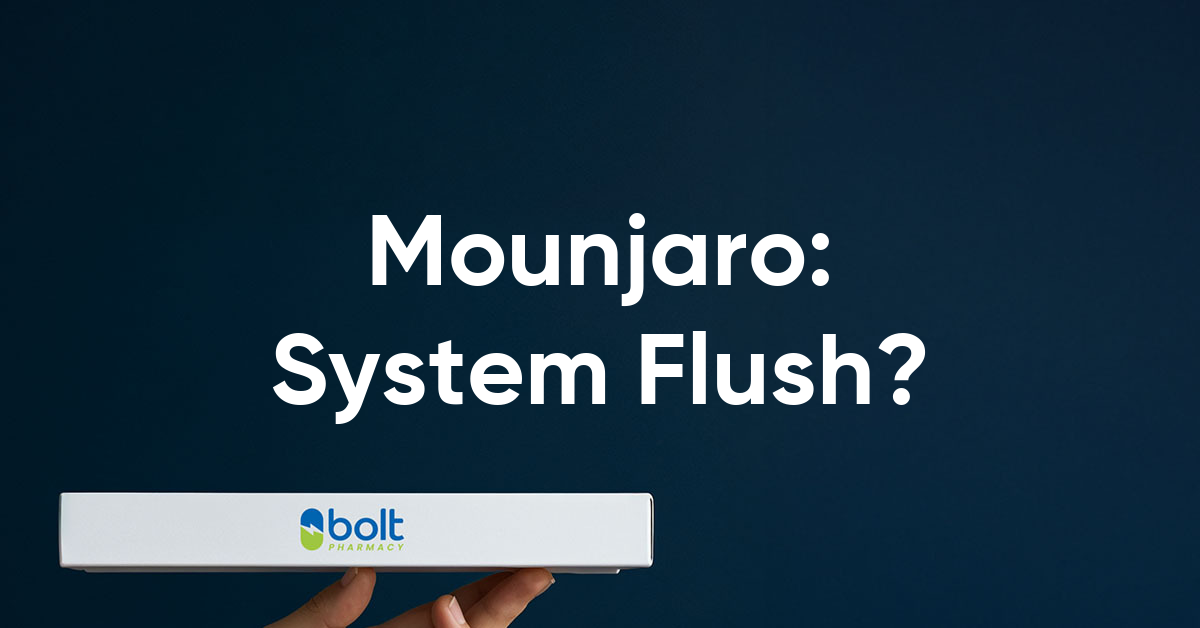
Mounjaro (tirzepatide) is a prescription medication used in the UK for type 2 diabetes and weight management. As a dual GIP and GLP-1 receptor agonist administered weekly, many patients wonder whether Mounjaro can be flushed from your system quickly. Understanding how this medication is eliminated from your body is essential for managing treatment expectations, planning for pregnancy, or addressing concerns about side effects. This article explains tirzepatide's elimination timeline, why accelerated clearance isn't possible, and when to seek medical guidance regarding your Mounjaro treatment.
Summary: Mounjaro (tirzepatide) cannot be flushed or rapidly eliminated from your system; it takes approximately 4 weeks after your last injection for the medication to be substantially cleared through natural metabolic processes.
Mounjaro is the brand name for tirzepatide, a prescription medicine licensed in the United Kingdom for the treatment of type 2 diabetes mellitus and, more recently, for weight management in adults with obesity or overweight with weight-related comorbidities. It belongs to a novel class of medications known as dual glucose-dependent insulinotropic polypeptide (GIP) and glucagon-like peptide-1 (GLP-1) receptor agonists. This dual mechanism distinguishes Mounjaro from other GLP-1 receptor agonists currently available.
Tirzepatide works by mimicking the action of two naturally occurring incretin hormones in the body. GLP-1 and GIP are released from the intestine in response to food intake and play crucial roles in regulating blood glucose levels. By activating both GIP and GLP-1 receptors, Mounjaro enhances insulin secretion from the pancreas when blood glucose levels are elevated, suppresses the release of glucagon (a hormone that raises blood sugar), slows gastric emptying to reduce post-meal glucose spikes, and promotes satiety, which helps reduce calorie intake.
The medication is administered as a once-weekly subcutaneous injection, typically into the abdomen, thigh, or upper arm. This extended dosing interval is possible due to the drug's long half-life and sustained action in the body. Mounjaro is available in various dose strengths, and treatment usually begins at a lower dose with gradual titration to minimise gastrointestinal side effects and optimise therapeutic benefit. The Medicines and Healthcare products Regulatory Agency (MHRA) has approved Mounjaro for use in adults aged 18 and over. For weight management, NICE guidance specifies eligibility criteria including a BMI threshold (typically ≥35 kg/m² or ≥30 kg/m² with weight-related comorbidities) and requires prescription within specialist weight management services.

Understanding how long Mounjaro remains in your system requires knowledge of its pharmacokinetic properties. Tirzepatide has an elimination half-life of approximately five days (around 120 hours) in most individuals. The half-life refers to the time it takes for the concentration of the drug in your bloodstream to reduce by half. This relatively long half-life is what allows for once-weekly dosing and contributes to the medication's sustained therapeutic effects.
Following the principle of pharmacokinetics, it generally takes approximately five half-lives for a medication to be considered effectively eliminated from the body, meaning that over 95% of the drug has been cleared. For Mounjaro, this translates to roughly 25 days (approximately four weeks) after your last injection before the medication is substantially removed from your system. Steady-state concentrations are typically reached after about 4 weeks of regular dosing.
The drug is primarily eliminated through protein catabolism, which means it is broken down into smaller peptide fragments and amino acids that are then metabolised by the body. According to the MHRA product information, no dose adjustment is required in patients with renal or hepatic impairment, as these conditions do not have a clinically relevant effect on tirzepatide exposure. However, patients with severe renal impairment may require closer monitoring for adverse effects related to dehydration or gastrointestinal symptoms. It is important to recognise that even after the drug is no longer detectable in measurable concentrations, some physiological effects may persist for a short period as your body readjusts to the absence of the medication. If planning pregnancy, it is typically advised to stop treatment at least one month before attempting conception; always confirm this timing with your prescriber.
From September 2025, the manufacturer of Mounjaro® is raising UK prices, meaning treatment costs will rise across pharmacies and providers. For some patients, this change is the main reason to explore alternatives. Wegovy® is a great alternative to Mounjaro and some people find it easier to tolerate. If you’re currently on Mounjaro and weighing up your options, now may be the right time to consider a switch.
Always speak with a clinician before changing medications. They’ll confirm timing and dosing for your situation.
There is no established medical method to safely accelerate the elimination of Mounjaro from your system once it has been administered. Unlike certain medications that can be removed through dialysis or specific antidotes, tirzepatide must be metabolised naturally by your body's physiological processes. Due to its large peptide structure and protein binding, dialysis is unlikely to be effective in removing tirzepatide. The notion of 'flushing' medications from your system through increased fluid intake, dietary changes, or other interventions is not supported by clinical evidence for this class of drugs.
Attempting to speed up elimination through unproven methods may be ineffective and potentially harmful. For instance, excessive fluid intake beyond normal hydration needs does not enhance the breakdown of peptide-based medications like tirzepatide and could lead to electrolyte imbalances. Similarly, there are no supplements, foods, or over-the-counter products that have been demonstrated to accelerate tirzepatide metabolism. The drug's elimination is governed by complex enzymatic processes that occur at a relatively fixed rate determined by your individual physiology.
If you are experiencing adverse effects from Mounjaro or have concerns about the medication remaining in your system, the most appropriate course of action is to discontinue further injections under medical supervision. Once you stop taking Mounjaro, your body will naturally eliminate the drug over the course of approximately four weeks, as discussed previously. During this period, it is important to monitor for any ongoing side effects and to discuss alternative treatment options with your healthcare provider if you were taking Mounjaro for diabetes management or weight control. If you experience severe symptoms, call 999 for emergency assistance or NHS 111 for urgent advice. Women using oral contraceptives should be aware that tirzepatide can delay gastric emptying and potentially reduce contraceptive effectiveness; additional non-oral contraception is recommended for 4 weeks after starting tirzepatide and for 4 weeks after each dose increase.
There are several important circumstances when you should contact your GP or healthcare provider regarding Mounjaro treatment. If you experience severe or persistent gastrointestinal symptoms such as nausea, vomiting, diarrhoea, or abdominal pain that interfere with your ability to eat or drink adequately, medical review is essential. These symptoms, whilst common with GLP-1 receptor agonists, can occasionally lead to dehydration or may indicate more serious conditions such as pancreatitis, particularly if accompanied by severe upper abdominal pain radiating to the back.
You should seek prompt medical attention if you develop symptoms suggestive of acute pancreatitis, including persistent severe abdominal pain, or if you notice signs of thyroid problems such as a lump or swelling in your neck, hoarseness, difficulty swallowing, or shortness of breath. The thyroid warning is based on findings in rodent studies, and the relevance to humans is unknown, but any concerning thyroid symptoms still warrant investigation. Additionally, if you experience symptoms of hypoglycaemia (low blood sugar) such as dizziness, sweating, confusion, or tremor—particularly if you are taking Mounjaro alongside other diabetes medications like insulin or sulphonylureas—contact your healthcare provider to discuss dose adjustments. If you take these medications, you should also be cautious about driving and discuss precautions with your healthcare provider.
Seek urgent medical help if you develop signs of gallbladder disease (persistent right upper abdominal pain, fever, jaundice), acute kidney injury (reduced urination, severe dehydration), or allergic reactions (rash, swelling, breathing difficulty). Call 999 for severe chest or abdominal pain, breathing problems, or signs of anaphylaxis, and use NHS 111 for urgent concerns that aren't immediately life-threatening. It is equally important to speak with your GP if you are considering stopping Mounjaro treatment, whether due to side effects, cost concerns, or other reasons. Abrupt discontinuation without medical guidance may lead to deterioration in glycaemic control if you have diabetes, or weight regain if prescribed for obesity management. Furthermore, if you are planning pregnancy, discover you are pregnant, or are breastfeeding, you must discuss Mounjaro use with your healthcare provider immediately, as the safety profile in these situations has not been fully established and treatment decisions require careful consideration of risks and benefits.
Mounjaro (tirzepatide) takes approximately 25 days (about 4 weeks) after your last injection to be substantially eliminated from your system, as it has a half-life of around 5 days and requires roughly 5 half-lives for over 95% clearance.
No, increased fluid intake does not accelerate tirzepatide elimination, as the medication is broken down through protein catabolism at a fixed rate determined by your body's natural enzymatic processes, and excessive hydration may cause electrolyte imbalances.
You should stop Mounjaro at least one month before attempting conception and discuss your plans with your healthcare provider, as the safety profile during pregnancy has not been fully established and requires careful medical consideration.
The health-related content published on this site is based on credible scientific sources and is periodically reviewed to ensure accuracy and relevance. Although we aim to reflect the most current medical knowledge, the material is meant for general education and awareness only.
The information on this site is not a substitute for professional medical advice. For any health concerns, please speak with a qualified medical professional. By using this information, you acknowledge responsibility for any decisions made and understand we are not liable for any consequences that may result.
Lorem ipsum dolor sit amet, consectetur adipiscing elit, sed do eiusmod tempor incididunt ut labore et dolore magna aliqua. Ut enim ad minim veniam, quis nostrud exercitation ullamco laboris nisi ut aliquip ex ea commodo consequat. Duis aute irure dolor in reprehenderit in voluptate velit esse cillum dolore eu fugiat nulla pariatur.
Block quote
Ordered list
Unordered list
Bold text
Emphasis
Superscript
Subscript